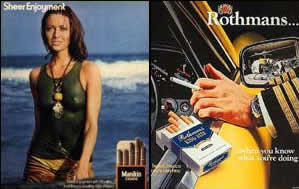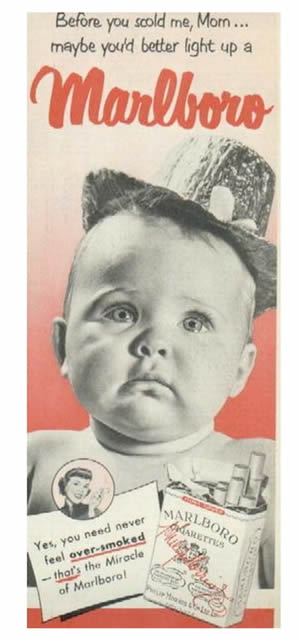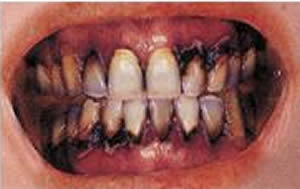Tobacco is the only product for human consumption, that is lethal when used as intended. Cigarettes are highly addictive due to the chemical nicotine and in many countries comprise the largest preventable cause of death.
Nicotine is one of the most addictive chemicals known. Up to 85% of smokers surveyed wished that they could stop smoking.
The damage cigarettes do to health is well documented. In the twentieth century, more people have been killed by tobacco than by war.
No other advertising campaign manages to screen out the horror of an addictive habit as the one mounted by the tobacco industry. Glamorous, youthful, healthy individuals are depicted with no reference to the unpleasant reality of smoking such as dry skin, bad breath and above all the many diseases that it causes. Tobacco advertising is based on contradictions.
"Alive with pleasure," proclaims an advert for the cigarette brand Newports, as if to distract the smoker from the government mandated label "Dead with cancer." The advertisement on the right has the caption "Sheer enjoyment". It depicts a connection between smoking and healthy, successful lifestyles. Nothing is further from the truth.

Smoking is linked with impotence, sterility and low levels of testosterone and yet the adverts, such as the one on the right, convey the message that masculinity is linked with smoking and heightened macho image.
Advertising is a very powerful form of myth-making. It does this by linking a product with the attribute or quality that we desire. For example a new suit that can make you look successful and sexy, detergent that can make you more appealing to your husband and fast cars that will make you appealing to the opposite sex.
Advertising is often innocent fun (myth-making) but in the case of tobacco it is downright dangerous. What are we gullible? YES.

Advertising by tobacco companies reached 2.5 billion dollars in the US in the late 1990s. Their claim is that they do not target non-smokers rather they attempt to persuade smoker to change brand. However only 10% of smokers will change brands in any given year. Surely a great deal of money is spent on so few people.
It is no secret that 75% of smokers are hooked by the time they turn 21. Tobacco advertising often targets young people, by portraying smoking as sexy, glamorous and associated with high adventure. .
Advertising is a powerful educational force that promotes attitudes, values as well as products. Most would argue that peer pressure is the major cause of youth taking up smoking. However, such arguments overlook the power of advertising. Advertising that links success and status with smoking is hard to resist for some at a youthful and vulnerable age. For young people image is important as they are more likely to be insecure about their image amongst their peers. Tobacco advertising exploits this and promotes smoking as a way to keep slim. This is especially important to young women who are bombarded with images in the media promoting, what can only be described as, unhealthy slim figures.
Click to see another. What does this advert say?

Terrie Hall, pictured on the right, has appeared in television tobacco commercials and started smoking when she was 18. She smoked two packs a day for twenty-two years before she was diagnosed with throat cancer. She had a permanent tracheotomy and has fought cancer seven times
Smoking causes cancer of the larynx and in particular the vocal cords. This may necesitate the removal of the larynx.
To understand the significance of a permanent tracheotomy answer the questions below.
What is tracheotomy? Is there a difference between permanent and temporary tracheotomy?
What is laryngectomy?
What is the purpose of the larynx?
What is the purpose of the epiglottis?
How is sound created?
How do patients which have undergone a permanent tracheotomy eat and speak?

Over 90% of oral cancers are caused by smoking.
In such cases radical surgery is required which disfigures the patient. The lower jaw is often removed.

When cancer has progressed thoughout the throat and mouth region more radical surgery is needed. This may involve removal of the lower jaw and larynx. Click to see the disfigurement of such a procedure. This picture was used in Mexico as part of an anti-smoking campaign.
Glamorous? I think not.

The percentage of people randomly selected who smoke.
The reason why they started smoking?
Would they like to give up the habit?
Have they tried? How many times? Were they successful?
What percentage of people between the age of 14 -20 smoke?
Is their a lower percentage of adults smoking?
Are more educated people less likely to smoke?
Look at some tobacco advertisements by clicking on the words below.
Advert(1)
Advert(2)
Advert(3)
Advert(4)
Who are they targeting? Explain how the advertisement achieves this.
What is the message the advertisement tries to convey?
Discuss why tobacco advertising is myth-making?

What does this show about the intent of the tobacco companies to target consumers?
"Marlboro’s phenomenal growth rate has been attributable in large part to our high market penetration among young smokers...15 to 19 years old...my own data, which includes younger teenagers, shows even higher Marlboro market penetration among 15-17-year-olds.”
Philip Morris report, 1975
”KOOL’s stake in the 16-25-year old population segment is such that the value of this audience should be accurately weighed and reflected in current media programs. As a result, all magazines will be reviewed to see how efficiently they reach this group.”